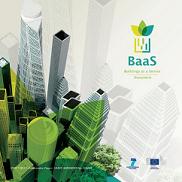BaaS Project
Background
There are a number of important elements in designing of building energy management systems – when data collection, aggregation and management is usually well addressed by existing building management systems, actual analytical components allowing to diagnose a behavior leading to excessive energy consumption and/or compromised occupants’ comfort are far less mature.
It is not only about developing algorithms for such tools, but also proper design of a hosting platform and its viability – it should not only enable access to sensor readings, but also provide access to other building data like Building Information Models and allow collaboration and interconnection of such analytics.
Developing a smart platform supporting these services naturally leads to a concept of the building as a service eco-system (BaaS) where any new tool can be plugged in the system and can benefit from already existing components.
Target
- Building and construction companies
- Process and systems integration engineering at buildings
- Building Automation and Building Management Systems companies
- Software developers
- IT Services and networks providers
- Energy providers and utilities companies
- Facility managers
- Energy Services Companies
- Public Authorities and Regulatory Bodies
- Building Owners
Objectives
The BaaS system aims to optimize energy performance in the application domain of “non-residential buildings, in operational stage. In the building operational life-cycle three significant tasks have to be continuously performed:
- collect information and assess the buildings current state;
- predict the effect that various decisions will have to Key Performance Indicators (KPIs);
- optimize performance
A generic ICT-enabled system will be developed to provide integrated assess, predict, optimize (APO) services that guarantee harmonious and parsimonious use of available resources. BaaS is supported on four objectives:
- Data Management from various in- and out-of-building sources: An (IFC-based) BIM server and DWH will act as central repositories for all static and dynamic building data. Other ICT systems and external web services, like a weather station or a weather forecast services, will be considered as data sources.
- System integration and interoperability concepts, based on standards and open source projects, will be applied on an Event-Driven SOA-based platform.
- Building thermal modeling and simulation for energy performance estimation, baselining, model assisted design of control and FDD.
- APO services: Anomaly identification (e.g. fault detection) and diagnosis services using sensed and simulated data; and Integrated and fully automated building automation and control design services.
Expected impact
- Significant reduction of energy consumption and CO2 emissions reaching or even surpassing the target of 15% reduction.
- Utilizing harmoniously and most effectively all installed systems in a building, taking into account human factors and adapting the decisions in real-time.
- Strengthen and consolidate European excellence in engineering at the intersection of control, thermal simulation, communication technologies, middleware platforms, energy, and building technologies.
- Contributing towards a unified European Methodology for a verifiable quantification of Energy Savings and CO2 reduction in buildings.
- Contributing to European Energy Policy and to the analysis and further investigation and enhancement of the EN 15232 and EN 15377.
- Impacting the evolution of standards for communication, interfaces, data models, methods of measuring energy performance, energy savings and CO2 reduction in the standardization bodies for building standards.




